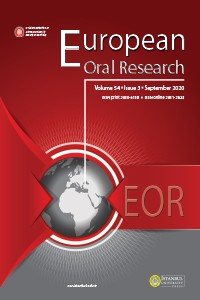Abstract
Purpose: An essential of successful dental prosthesis is dental models. Voids present in dental models decreases accuracy and strength. This study investigates void formation in models fabricated by a new technique. The technique described in the study was based upon increasing soaking time of gypsum powder in water.
Materials and methods: Voids in hand mixed, hand mixed after a soaking time of 1.5 minutes and vacuum mixed samples were examined. The voids were counted via a stereomicroscope and diameters of voids were recorded in 2 categories (0.01-0.05mm, 0.051-0.1mm). The amounts of voids were compared between the samples prepared with 3 methods. Results: The samples prepared by conventional hand mixing method had the highest total number of voids and smaller voids. There was no significant difference between the amount of voids in the samples prepared by soaking powder in water and by mixing under vacuum. Conclusion: Soaking gypsum powder in water for 1.5 minutes before mixing may be an alternative to mixing gypsum under vacuum to avoid void formation in dental models.
Supporting Institution
The authors declared that they have received no financial support.
References
- 1. Eakle WS, Hatrick. Dental Materials: Clinical Applications for Dental Assistants and Dental Hygienists. Missouri: Elsevier, 2016.
- 2. Reisbick MH, Garrett R, Smith DD. Some effects of device versus handmixing of irreversible hydrocolloids. J Prosthet Dent 1982;47:92-94.
- 3. Soğancı G, Cebeci NÖ, Yağcı F. Ed. Cebeci NÖ. Diş Hekimliğinde Maddeler Bilgisi. Ankara: Atlas Kitapçılık, 2015.
- 4. Schelb E. Using a syringe to make void-free casts from elastomeric impressions. J Prosthet Dent 1988;60:121-122.
- 5. Abdullah MA. Effect of frequency and amplitude of vibration on void formation in dies poured from polyvinyl siloxane impressions. J Prosthet Dent 1998;80:490-494.
- 6. Reddy NK, Aparna I. Effect of frequency and amplitude of vibration and role of a surfactant on void formation in models poured from polyvinyl siloxane impressions. J Conserv Dent 2011;14:151-155.
- 7. Reddy GV, Reddy NS, Itttigi J, Jagadeesh KN. A comparative study to determine the wettability and castability of different elastomeric impression materials. J Contemp Dent Pract 2012;13:356-363.
- 8. Arora N, Arora M, Gupta N, Agarwal M, Verma R, Rathod P. Clinical Evaluation of Different Pre-impression Preparation Procedures of Dental Arch. J Int Oral Health 2015;7:80-84.
- 9. Sakaguchi RL, Ferracane J, Powers JM. Craig's Restorative Dental Materials. Missouri: Elsevier, 2019.
- 10. Reddy GV, Reddy NS, Itttigi J, Jagadeesh KN. A comparative study to determine the wettability and castability of different elastomeric impression materials. J Contemp Dent Pract 2012;13:356-363.
- 11. Arora N, Arora M, Gupta N, Agarwal M, Verma R, Rathod P. Clinical Evaluation of Different Pre-impression Preparation Procedures of Dental Arch. J Int Oral Health 2015;7:80-84.
- 12. Jassim TK. Comparison of Some Properties between Commercially Available Gypsum Products TJDS 2012;1:63-69.
- 13. Akpınar YZ, Aslan MA, Tatar N, Yılmaz B. A vacuum cabin technique in the production of master model. Selcuk Dent J 2015;2: 17-121.
- 14. Jeong YG, Lee WS, Lee KB. Accuracy evaluation of dental models manufactured by CAD/CAM milling method and 3D printing method. J Adv Prosthodont 2018;10:245-251.
- 15. Kim WT. Accuracy of dental models fabricated by CAD/CAM milling method and 3D printing method. J Oral Res 2018;7:127-133.
Abstract
References
- 1. Eakle WS, Hatrick. Dental Materials: Clinical Applications for Dental Assistants and Dental Hygienists. Missouri: Elsevier, 2016.
- 2. Reisbick MH, Garrett R, Smith DD. Some effects of device versus handmixing of irreversible hydrocolloids. J Prosthet Dent 1982;47:92-94.
- 3. Soğancı G, Cebeci NÖ, Yağcı F. Ed. Cebeci NÖ. Diş Hekimliğinde Maddeler Bilgisi. Ankara: Atlas Kitapçılık, 2015.
- 4. Schelb E. Using a syringe to make void-free casts from elastomeric impressions. J Prosthet Dent 1988;60:121-122.
- 5. Abdullah MA. Effect of frequency and amplitude of vibration on void formation in dies poured from polyvinyl siloxane impressions. J Prosthet Dent 1998;80:490-494.
- 6. Reddy NK, Aparna I. Effect of frequency and amplitude of vibration and role of a surfactant on void formation in models poured from polyvinyl siloxane impressions. J Conserv Dent 2011;14:151-155.
- 7. Reddy GV, Reddy NS, Itttigi J, Jagadeesh KN. A comparative study to determine the wettability and castability of different elastomeric impression materials. J Contemp Dent Pract 2012;13:356-363.
- 8. Arora N, Arora M, Gupta N, Agarwal M, Verma R, Rathod P. Clinical Evaluation of Different Pre-impression Preparation Procedures of Dental Arch. J Int Oral Health 2015;7:80-84.
- 9. Sakaguchi RL, Ferracane J, Powers JM. Craig's Restorative Dental Materials. Missouri: Elsevier, 2019.
- 10. Reddy GV, Reddy NS, Itttigi J, Jagadeesh KN. A comparative study to determine the wettability and castability of different elastomeric impression materials. J Contemp Dent Pract 2012;13:356-363.
- 11. Arora N, Arora M, Gupta N, Agarwal M, Verma R, Rathod P. Clinical Evaluation of Different Pre-impression Preparation Procedures of Dental Arch. J Int Oral Health 2015;7:80-84.
- 12. Jassim TK. Comparison of Some Properties between Commercially Available Gypsum Products TJDS 2012;1:63-69.
- 13. Akpınar YZ, Aslan MA, Tatar N, Yılmaz B. A vacuum cabin technique in the production of master model. Selcuk Dent J 2015;2: 17-121.
- 14. Jeong YG, Lee WS, Lee KB. Accuracy evaluation of dental models manufactured by CAD/CAM milling method and 3D printing method. J Adv Prosthodont 2018;10:245-251.
- 15. Kim WT. Accuracy of dental models fabricated by CAD/CAM milling method and 3D printing method. J Oral Res 2018;7:127-133.
Details
| Primary Language | English |
|---|---|
| Subjects | Dentistry |
| Journal Section | Original Research Articles |
| Authors | |
| Publication Date | January 5, 2021 |
| Submission Date | August 13, 2019 |
| Published in Issue | Year 2020 Volume: 54 Issue: 3 |


